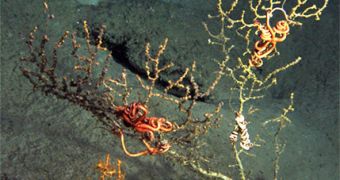A collaboration of researchers in the United States has just finished conducting a multi-week expedition in the Gulf of Mexico, which sought to determine the health status of coral reefs and other related marine communities. Multiple signs of recent damage were discovered.
Scientists from governmental agencies, universities and research institutes collaborated in this research, which targeted deep-sea coral habitats primarily. The recent mission was the fourth in a multi-year effort to investigate the state of ecosystems in the Gulf.
The collaboration received funds from the Office of Ocean Exploration and Research at the US National Oceanic and Atmospheric Administration (NOAA), as well as from the Bureau of Ocean Energy Management, Regulation and Enforcement (BOEMRE).
Most investigations conducted within this science sortie were conducted at a depth of around 1,400 meters deep (roughly 4,600 feet), from aboard the NOAA R/V Ronald H. Brownand.
The National Deep Submergence Facility also aided the efforts, by providing the remotely-operated vehicle (ROV) Jason II. The submarine made it easier for experts to look at deep-sea coral reefs.
At a site located some 7 miles southwest of the Macondo wellhead, the investigators discovered destroyed and dying reefs that were bleached. Bleaching equals a death sentence for corals. With the increased levels of acid in the world's oceans, the phenomenon is growing increasingly common.
“These observations capture our concern for impacts to marine life in places in the Gulf that are not easily seen,” says NOAA administrator Jane Lubchenco, PhD.
“Continued, ongoing research and monitoring involving academic and government scientists are essential for comprehensive understanding of impacts to the Gulf,” adds the official, who is also the US under secretary for commerce for oceans and atmosphere.
During the new investigation, the ROV collected samples of corals that had been affected by a brown substance, which is probably the main culprit behind their death and discoloration.
The chief scientist of the expedition was Penn State University biology professor Charles Fisher PhD. He says that the brown substance and the samples were sent to labs for analyses.
“Through the continued work of ongoing research projects such as this, BOEMRE scientists, other government scientists, academia and the public can better understand the potential effects of offshore energy exploration and development, including the possible effects of the Deepwater Horizon blowout and spill,” explains Michael R. Bromwich, the director of BOEMRE.
“Today’s preliminary observations highlight the need for continued scientific research in the Gulf of Mexico,” he goes on to say.

 14 DAY TRIAL //
14 DAY TRIAL //